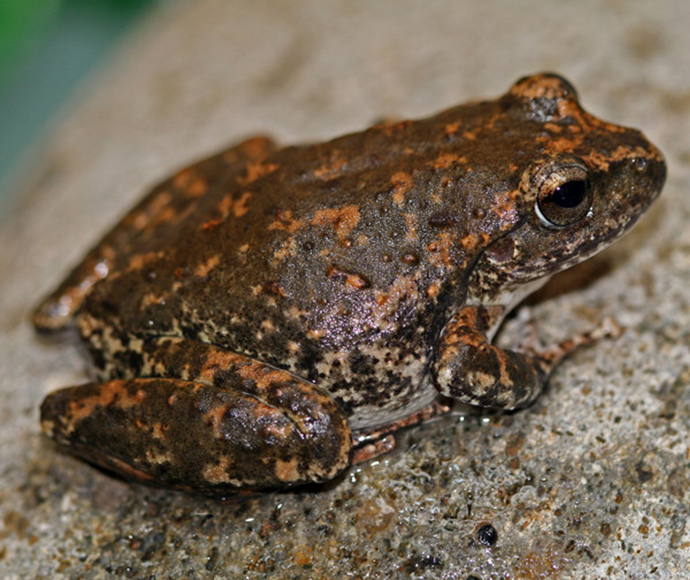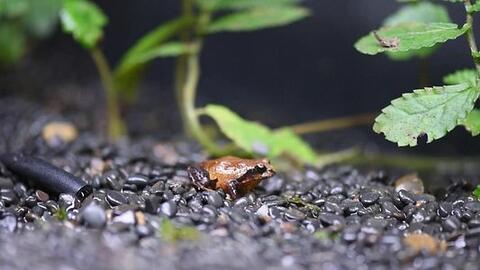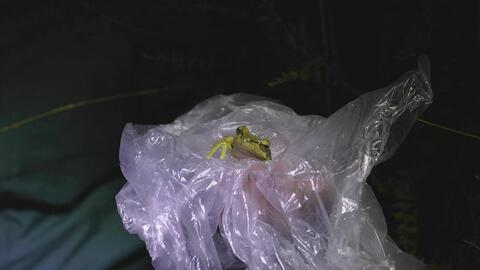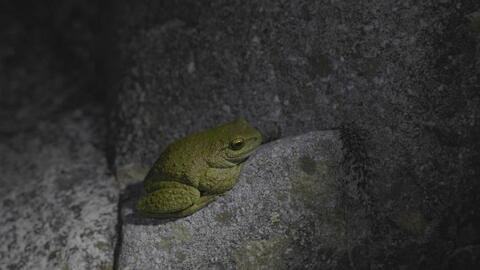Let's talk about frogs
More than one-third of the world's 7,500 frog species are in danger of extinction, which is an alarming statistic. World Frog Day, observed on 20 March, is dedicated to raising awareness of the plight of threatened frog species and how we can help conserve them. Let's take a look at the situation closer to home.
Australia is home to more than 240 different frog species, many of which are not found anywhere else on Earth. Close to 20% of Australian frogs are threatened; in the last 25 years, 6 have already been listed as extinct.
Every species that disappears is a sign of biodiversity decline.
Many threatened frog species are unlikely to survive without help.
At Saving our Species, we are committed to securing the future of New South Wales's threatened frogs and currently have conservation projects in place for 16 of the most threatened frog species.
Our conservation projects include actions like establishing insurance populations, breeding and release programs, the delivery of water for the environment to wetlands, habitat protection, scientific research and monitoring.
Let’s take a closer look at 4 of these projects as well as find out what we can all do to help.
Did you know?
The primary threats to Australian frogs are:
- disease caused by amphibian chytrid fungus (Batrachochytrium dendrobatidis), capable of causing sporadic deaths in some frog populations and 100% mortality in others
- climate change-induced pressures such as drought and fire
- habitat loss, destruction and fragmentation from human development.

Gondwana Rainforest mountain frogs
A group of incredibly rare and special mountain frogs in the genus Philoria, are surviving within the Gondwana World Heritage-listed rainforests of northern New South Wales and south-east Queensland.
These frogs are an ancient species and have evolved alongside the rainforests they have inhabited over millions of years, but they are under threat and face extinction.
- Richmond Range mountain frog (P. richmondensis)
- Red and yellow mountain frog (P. kundagungan)
- Loveridge's mountain frog (P. loveridgei)
- Pugh's mountain frog (P. pughi)
- Sphagnum frog (P. sphagnicola)
The Mount Ballow mountain frog (P. knowlesi) was only discovered in 2022, and its threatened species status is still being assessed.
Did you know?
These frogs survive in isolated headwater seepages and streams on mountain tops and are effectively stranded on 'islands in the sky'. Each mountain top is separated from the others by a 'sea' of unsuitable lower-altitude habitat. These frogs are at risk of extinction primarily due to climate change. As warmer and drier habitat prevails the 'islands in the sky' may become unsuitable habitat.
Threats to these species include disease caused by the amphibian chytrid fungus and habitat destruction caused by feral pigs. Saving our Species is working with a number of partners to safeguard populations and prevent these frogs from extinction. These include:
- feral pig control and fencing around critical breeding habitat, led by the NSW National Parks and Wildlife Service
- coordination of on-ground actions across both New South Wales and Queensland, through a working group consisting of threatened species specialists and staff from the NSW National Parks and Wildlife Service and QLD Parks and Wildlife Service
- establishment of an insurance population in captivity for P. richmondensis and P. kundagungan through the Gondwana Rainforest Amphibian Survival Program (Project GRASP), led by Dr David Newell from Southern Cross University in collaboration with Saving our Species, WWF Australia (through the Rewilding Australia Project) and the Commonwealth Bushfire Recovery Fund for Wildlife and Habitat.
The next steps in this conservation project include genetic rescue and translocation to bolster wild populations, and reintroducing populations into areas where they have disappeared. The long-term aim is to increase the resilience and ability of these species to adapt to a warming, drying climate to cope with climatic changes.
Report feral pig sightings
You can help save these Gondwana Rainforest mountain frogs. If you spot a feral pig in Richmond Range National Park, Toonumbar National Park, Yabbra National Park, Koreelah National Park or Tooloom National Park, report your sighting to the NSW National Parks and Wildlife Service. This includes sightings of scats and tracks. Include the location, number of pigs and a photo if you can get one.
The sightings you report can help us learn about the distribution and movement pathways of feral pigs. We can use this to develop management strategies that better protect threatened species from extinction.

Gondwana Rainforest mountain frog. Video: Nick Wall/Airswing Media and Shannon Greenfields/DCCEEW. Sound: Liam Bolitho/Southern Cross University.
Booroolong frog
The Booroolong frog (Litoria booroolongensis) was once widespread, but disease caused by the amphibian chytrid fungus has caused it to disappear from more than half its range. This endangered frog is now restricted to isolated populations in rocky streams on the tablelands and slopes of New South Wales.
Did you know?
Male Booroolong frogs usually only live for a single breeding season. They experience large fluctuations in population abundance from one year to the next, depending on stream flows and are particularly vulnerable when streams dry.
Other threats to Booroolong frogs include modification of stream channels and flow, alteration of water quality, loss of habitat, weed invasion and predation of eggs and tadpoles by introduced fish.
Saving our Species supports conservation outcomes for the Booroolong frog, to protect its habitat by working with landowners to:
- install fences along sections of stream and promote the establishment of native riparian vegetation
- control invasive weeds that smother breeding habitat
- control feral pigs to protect important riparian habitat.
This project is led by the Saving our Species program in collaboration with NSW National Parks and Wildlife Service, Local Land Services (LLS), NSW Department of Primary Industries (DPI) – Fisheries, the NSW Environmental Trust, Southern Cross Forests, Taronga Zoo, the Australian Museum, PF Olsen Australia and many participating landholders.
Responding to crisis
Devastatingly, the northern population of Booroolong frog was almost entirely lost at the height of the drought in 2019.
Responding to the crisis, Saving our Species partnered with frog ecologists, the Australian Museum and Taronga Zoo to establish a captive insurance and breeding population at the zoo.
Since its establishment in 2019, Taronga's breeding program has successfully bred from most pairings with 110 frogs now forming a genetically diverse insurance population in the purpose-built facility.
Almost 1,300 endangered Booroolong frogs bred at Taronga Zoo have now been released into streams in Northern New South Wales, and the released frogs appear to be doing very well.

Booroolong frog (Litoria booroolongensis). Frog call: supplied by Ed McNabb. Video and sound: Alex Pike/DCCEEW.
Southern heath frog
Southern heath frog (Litoria watsoni) is an endangered tree frog that is only known to occur from Budderoo National Park in the Illawarra region of New South Wales, along the eastern fall of the Great Dividing Range. Threats include disease caused by the amphibian chytrid fungus, habitat disturbance from bushfire or sand mining, climate change and predation by native and introduced fish.
Did you know?
Southern heath frog is very similar to Littlejohn's tree frog (Litoria littlejohni) and was only described as a genetically distinct species in 2020. Southern heath frog is distinguishable by its call, with a lower average number of pulses in each note compared to Littlejohn's tree frog.
Saving our Species supports conservation outcomes for southern heath frog through:
- monitoring, across multiple known sites, and exploratory surveys to determine the species range
- genetic research, to determine genetic population size, inbreeding and potential for adaptive responses.
The genetic and occupancy data gathered helps us understand how far these frogs disperse, the population viability at sites over the long-term, and plan for management interventions and assess their success.
New populations discovered
Four new populations of southern heath frog were discovered in late 2023, expanding the known range for this threatened species. Saving our Species staff made the discoveries, at the top of sandstone monoliths within Morton National Park.
Some of the sites where the frogs were discovered, contain permanent breeding pools enabling the species to breed every year. This provides hope for the species as it appears populations are persisting despite the 2019–20 bushfires and drought in 2023.
These sites are now prioritised as some of the most important places to protect.
This project is led by the Saving our Species program in collaboration with the NSW National Parks and Wildlife Service, Forestry Corporation NSW, University of Newcastle, the Commonwealth Government, and frog specialists Garry Daly, Phil Craven and Michael Mahony.

Southern heath frog (Litoria watsoni). Video and sound: Rachel Melrose/DCCEEW and Alex Pike/DCCEEW.
Spotted tree frog
The critically endangered spotted tree frog (Litoria spenceri) belongs to an ancient group of Gondwanan tree frogs and has evolved alongside the environment over millions of years. This species lives in only a few high mountain streams in Victoria, and a single location in New South Wales, within Kosciuszko National Park.
Did you know?
In the summer of 1998, with the last remaining frogs in New South Wales succumbing to disease caused by the amphibian chytrid fungus, research scientists set out on an emergency rescue operation to collect frogs for captive breeding.
However, they found the remaining wild population in Kosciuszko had just a solitary, lonely male frog, his unanswered mating calls resounding through the catchment. He was the last wild spotted tree frog left in New South Wales.
With breeding partners sourced from Victoria, this sole surviving male began a decades-long breeding operation to repopulate wild spotted tree frogs into their former habitat in New South Wales.
Saving our Species supports the conservation of spotted tree frogs in New South Wales through translocations and habitat management.
Initially, captive-bred frogs thrived after being released back into the wild. However, it was not long before the frogs faced infection from chytrid fungus, which again decimated their numbers in the wild.
But chytrid has a weakness. It does not like environments with temperatures over 28C. So, in 2014, researchers started an experimental wild colony of spotted tree frogs in a new catchment with warmer conditions. To everyone's delight, they thrived.
The higher temperatures of the catchment, along with the frog's habit of sun basking on warm rocks along the river, resulting in a high post-release survivorship of frogs and subsequent breeding for the first 5 years.
Devastatingly, this newly established population abruptly crashed after a wildfire in 2020, followed shortly by an amphibian chytrid fungus outbreak.
To overcome this setback, in 2022, 80 frogs were released at the site where the species thrived before the 2020 wildfires. Monitoring has since found the released frogs are healthy, disease-free and breeding. The most recent monitoring at the site found over 200 spotted tree frogs ranging in age from juveniles to adults, which is a clear sign the population is recovering from the recent wildfire and disease impacts.
This project is led by the Saving our Species program in partnership with the Amphibian Research Centre in Melbourne, which maintains a breeding colony of spotted tree frogs for release in New South Wales. The NSW Environmental Trust has provided funding for analysing chytrid swabs.

Spotted tree frog (Litoria spenceri). Video: Alex Pike/DCCEEW. Frog Call: Supplied by Nathan Litjens.
Looking ahead
Saving our Species is fortunate to have some of Australia's leading conservation biologists in frog research and ecology developing and delivering collaborative strategies, informed by research and monitoring, to improve the long-term prospects of threatened frogs.
Conservation strategies for these species build on decades of research and management as well as longstanding partnerships between different agencies and individuals.
Calling citizen scientists
FrogID is a national citizen science project that is helping scientists learn more about what is happening to Australia's frogs. Download the FrogID app and you can discover which frogs live around you and help monitor Australia's frog population.
Learn more
- Find out more about how we are securing a future for our threatened species and the Saving our Species program.
- Learn more about how to spot a sick frog, and the threats to frogs.
- Learn how to take precautions against the amphibian chytrid fungus.
- Learn more about the fascinating world of frogs, listen to their calls, and find out how you can help protect them.